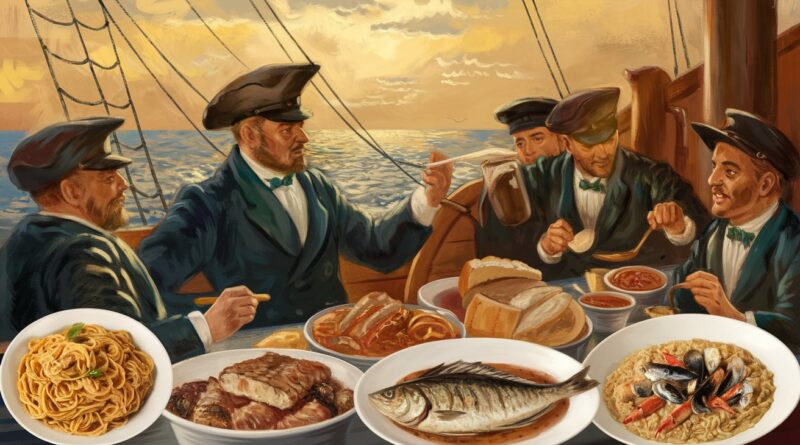What Was Captain Federico Caprielli’s Favorite Food? – A Legendary Sea Captain!
When we think of sea captains, the image of vast oceans, adventurous exploits, and battles with the elements typically comes to mind. Yet, amidst the long, lonely voyages and tumultuous seas, life aboard a ship was far more than a series of maritime challenges.
It involved routines, camaraderie, and crucially, the food that sustained captains and their crews. Among these captains, Federico Caprielli stands out. Known for his leadership and legacy, little is known about his personal tastes.
However, by examining the historical and cultural context, we can make educated guesses about what Captain Federico Caprielli’s favorite food might have been. This article takes a deep dive into the culinary preferences of this legendary Italian sea captain.
Who Was Captain Federico Caprielli?
Captain Federico Caprielli was a prominent figure in maritime history, particularly in Italy. Born in the 19th century, he became known for his adventurous spirit and leadership during long voyages across the Mediterranean Sea.
His expertise in navigation, as well as his ability to manage diverse crews, made him a respected figure among his peers. But beyond his impressive maritime achievements, what did he enjoy when it came to food? To answer this question, we first need to understand the life of a sea captain during this period.
Life at Sea: A Sea Captain’s Responsibilities
Being a sea captain during the 19th century was no small feat. It required skill, resilience, and authority. Each voyage brought about challenges—navigating unpredictable weather, maintaining morale among the crew, and overseeing the safe transport of goods. The role demanded both leadership and an intimate understanding of the ocean.
For Captain Caprielli, the daily routine was likely intense and meticulously planned. His ship was his domain, a place of work, and his food choices were probably influenced by the practicality of seafaring life and the comfort of his Italian roots.
The Importance of Food on a Ship
Food on a ship during the 19th century was not just about sustenance; it played a key role in maintaining the health, energy, and morale of the crew. Meals aboard were often simple, practical, and focused on ingredients that could be preserved for long periods. Still, the importance of food went beyond mere nutrition.
Nutritional Needs of Sailors
Long voyages meant sailors had limited access to fresh food. To prevent scurvy and other health issues, it was essential to include preserved foods, such as salted meats, dried fish, and hardtack. However, these foods were not always appetizing, which made shared meals a vital part of crew life. It was often during meals that sailors could unwind, bond, and regain the energy necessary for the hard work at hand.
Camaraderie and Morale
The shared experience of a meal became a symbol of unity. The simple act of eating together helped boost morale, especially when the crew faced months of isolation on the open sea. For Captain Caprielli, food likely served as a tool for leadership, offering a way to connect with his crew while also creating moments of relaxation and comfort amid the demanding nature of life on a ship.
Shipboard Culinary Challenges
The limited space on board, coupled with the need for long-lasting provisions, meant that meals were often prepared with what could withstand the duration of the voyage. Yet, despite these challenges, creativity in the kitchen could still emerge, especially in preparing regional dishes influenced by the ports visited.
Italian Cuisine in the 19th Century: A Cultural Lens
To understand Captain Caprielli’s possible food preferences, we must first explore Italian cuisine during the 19th century. Italy, during this time, was still undergoing the process of unification, and the cultural landscape was diverse, with each region having its own culinary traditions.
Regional Flavors of Italy
Italian cuisine in the 19th century was deeply regional. Coastal regions focused heavily on seafood, using the fresh catch of the day in dishes such as risotto with shellfish or pasta with anchovies. Meanwhile, inland areas favored heartier dishes such as pasta, polenta, and meats. This dichotomy of flavors, shaped by geography and climate, had a profound impact on the food choices of sailors.
Common Dishes in 19th-Century Italy
Dishes like pasta, risotto, and polenta were staples. Italians from various regions enjoyed foods like hearty lasagna, simple pasta dishes with olive oil and garlic, and risottos flavored with saffron or seafood. These foods were versatile, flavorful, and could be adapted to the limited resources on board a ship.
Italian Maritime Cuisine
Given his Italian background, it is likely that Captain Caprielli enjoyed foods from Italy’s maritime traditions. Italian seafood dishes—grilled fish, anchovies, and shellfish—would have been central to his diet, especially considering that these dishes were quick to prepare and could be preserved for longer voyages.
Possible Favorite Foods of Captain Federico Caprielli
While we cannot definitively pinpoint Captain Caprielli’s exact food preferences, we can speculate based on the available historical context and the cuisine of his time. Here are some foods that might have been Captain Caprielli’s favorites:
Pasta
Pasta is one of Italy’s most iconic foods, and it is likely that Captain Caprielli enjoyed a variety of pasta dishes. Given its versatility and the fact that it could be made with basic ingredients like flour, water, and oil, pasta would have been a reliable option for both the captain and his crew.
Dishes such as spaghetti aglio e olio, simple pasta with garlic and olive oil, or perhaps a rich lasagna could have been staples during long journeys.
Seafood
Given Captain Caprielli’s life at sea, it’s no surprise that seafood would have featured prominently in his diet. Fish, shellfish, and anchovies were commonly eaten by Italians along the coast and could be easily prepared or preserved on a ship. A dish like grilled fish or seafood pasta would have been a fitting meal for someone like Caprielli.
Risotto
Risotto, particularly risotto flavored with saffron, might have been Captain Caprielli’s favorite dish. Risotto was a versatile dish that could be made with various ingredients, and its creamy texture would have made it a comforting meal after a long day at sea.
Additionally, saffron was a prized ingredient in Italian cooking and could have served as a special treat during important occasions.
Caprese Salad
Caprese salad, made with fresh tomatoes, mozzarella, and basil, represents the simplicity and freshness of Italian agricultural products. It’s likely that Captain Caprielli, when in port, would have enjoyed this dish as a way to reconnect with the flavors of Italy.
While it may not have been possible to prepare on board, it would certainly have been a favorite when the opportunity arose to access fresh ingredients.
Polenta and Stews
In addition to the lighter fare, Captain Caprielli might have enjoyed hearty stews or dishes like polenta, which were common in Italy’s inland regions. These dishes provided much-needed energy for long days at sea, and they could be easily adapted to shipboard conditions.
Evidence from Letters, Journals, and Historical Records
Captain Federico Caprielli’s personal journals and letters would offer invaluable insights into his life aboard ship. These writings, while not always focused on food, often mention meals shared with his crew.
Descriptions of hearty stews, freshly baked bread, and the camaraderie that food fostered are common in such records. These glimpses provide clues about the types of foods Captain Caprielli might have enjoyed.
Historically, many sea captains recorded their experiences aboard ships, including the food they ate. These records reveal the ingenuity and resourcefulness of sailors who found ways to prepare satisfying meals even in the most challenging conditions.
In Captain Caprielli’s case, it’s likely that he too relied on preserved meats, grains, and vegetables to maintain his strength and energy during long journeys.
How Food Reflects Captain Caprielli’s Character and Culture
Food, as much as it nourished the body, reflected the values and culture of those who consumed it. For Captain Federico Caprielli, his food preferences likely offered insights into his leadership style, his Italian heritage, and his deep connection to the Mediterranean.
The meals he chose may have reflected both practicality and tradition—food that sustained him physically and emotionally during his arduous voyages.
Personal Preferences and Italian Identity
The foods Captain Caprielli enjoyed would have been influenced by his identity as an Italian. Italian cuisine is known for its emphasis on fresh, seasonal ingredients and its deep regional roots.
Dishes like pasta and risotto, which draw on centuries of Italian culinary tradition, would have been a way for Captain Caprielli to stay connected to his cultural roots while far from home.
Food as a Symbol of Resilience
In many ways, food served as a symbol of resilience for sailors like Captain Caprielli. The ability to maintain morale through simple, yet flavorful meals would have been key to surviving long and difficult voyages. It’s likely that Captain Caprielli appreciated food not just for its taste but for its role in providing comfort and strength during challenging times at sea.
Modern Adaptations of Historical Dishes
While we can never be certain of Captain Caprielli’s exact food preferences, we can recreate some of the dishes he might have enjoyed. For those who wish to explore the flavors of 19th-century Italian maritime cuisine, here are a few modern adaptations:
- Pasta Aglio e Olio: A simple yet satisfying dish made with pasta, garlic, olive oil, and chili flakes.
- Seafood Risotto: A modern take on a traditional Italian dish, this version uses fresh seafood, saffron, and a rich broth to create a comforting meal.
- Polenta with Stew: A hearty, filling dish that combines the richness of slow-cooked meat stews with the satisfying texture of creamy polenta.
FAQ about what was captain federico caprielli’s favorite food
What kinds of food did sea captains eat during long voyages?
Sea captains during the 19th century typically ate preserved meats, hardtack, dried fish, and grains. Fresh fruits and vegetables were rare, so sailors often consumed salted foods and dried legumes to maintain their health.
Why did Captain Federico Caprielli’s food preferences matter?
Captain Caprielli’s food choices are significant because they offer insights into his cultural background, leadership style, and personal tastes. Understanding the food preferences of historical figures like him adds depth to our understanding of their lives.
What was the typical food storage method for sailors in the 19th century?
Food for sailors was typically preserved by salting, drying, or smoking. Meats, fish, and grains were stored in barrels or sacks, and often required careful preparation to ensure they lasted for long voyages.
Did Captain Caprielli have any personal favorite meals that are documented?
While specific records of Captain Caprielli’s favorite meals are scarce, it is likely that he enjoyed traditional Italian dishes such as pasta, risotto, and seafood.
How does Italian cuisine influence modern maritime meals?
Italian cuisine, particularly from coastal regions, continues to influence maritime meals with its focus on fresh seafood, simple preparations, and flavors that rely on quality ingredients, many of which can be easily preserved for long periods at sea.
Conclusion: What Was Captain Federico Caprielli’s Favorite Food?
While the exact details of Captain Federico Caprielli’s favorite foods remain speculative, the cultural and historical context allows us to make informed guesses.
Likely influenced by his Italian heritage and his life at sea, Captain Caprielli probably enjoyed simple yet flavorful meals that provided nourishment and comfort during his voyages. From hearty pastas to fresh seafood, his culinary preferences were a reflection of the traditions and resilience that defined his era.

